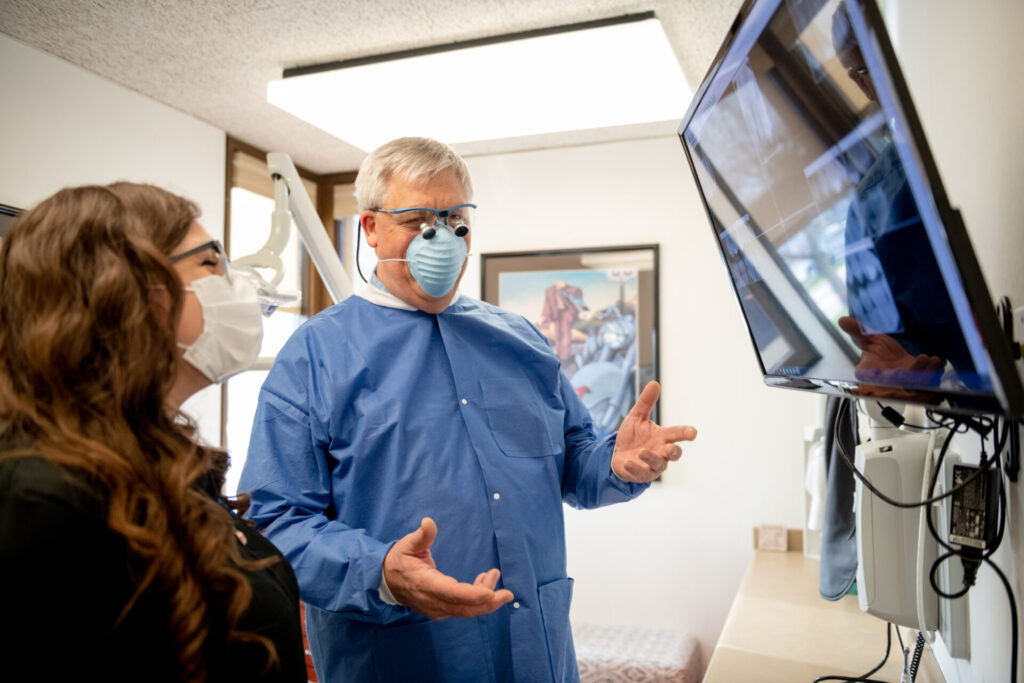In January of 2020, at Dr. Perry K. Tuneberg & Associates, a Rockford, Ill., general dental practice, the new year started with a recent implementation of new front office technology.
The new suite of digital business solutions was remarkable for what it wasn’t – their old, cumbersome system that drained staff hours and labor. But the staff had no clue then just how much deeper the benefits would go a few months later as the COVID-19 pandemic closed businesses and ushered in a new normal of safety.
While Dr. Tuneberg’s dental practice had to adjust to COVID-19 in many ways, their payment and billing process was already up to speed.
With Rectangle Health’s suite of digital payment technologies, they had an abundance of benefits to face a health emergency era that they couldn’t have predicted.
In this e-book, Dr. Tuneberg and his team relay how his practice evaluated, implemented, and acclimated to their new digital business solutions. With guidance from practice consultant Kyle Bogan, D.D.S., of Delaware, Ohio, it also details a variety of tactics that other dental offices can use to smooth the way for onboarding new technologies.
So Much More than They Bargained For
For Dr. Tuneberg, the urge to upgrade his practice’s administrative functions came rather passionately from his team. They had been broaching the subject of much-needed changes, and he sensed it was time to listen up. The practice had an administrative technology deficit that the front office recognized as a significant issue that needed to be addressed. Casey Jones, Dr. Tuneberg’s office manager, heard about Practice Management Bridge®, a faster, easier, and more dynamic payments technology, through the dental front office grapevine and decided it was worth a look. What she encountered was a suite of digital payments solutions that ultimately would revolutionize, in bigger ways than could be appreciated then, how they do business at Dr. Perry K. Tuneberg & Associates.
“We’ve come a long way,” Ms. Jones said. Dr. Tuneberg agrees.
The newly instituted technology was robust enough to address the practice’s payment processing and billing pain points, but it actually offered far more.
Having the Rectangle Health digital payments solutions system already in play when COVID-19 began shutting down major parts of the world in spring 2020 was a nick-of-time windfall for the practice. Access to new, streamlined, and contactless payment features meant drastically decreased physical interaction between administrative staff and patients. It also meant that patients and staff interacted less frequently with high-touchpoint equipment, such as traditional credit card processing terminals.
These were suddenly premium features to emerge from the already revolutionizing system, Dr. Tuneberg said.
Turns out, as well, that the new system helped to assuage the fears of anxious patients in several ways.
Before the pandemic, Practice Management Bridge offered new assurances that their data was encrypted and not able to be randomly accessed, which wasn’t the case previously. “It puts the patient at ease knowing their credit card isn’t just sitting around here in the office,” Ms. Jones said.
After the pandemic, it helped patients feel more secure in person-to-person interactions with front desk staffers processing their payments and setting up any necessary payment plans.
Patients are understandably nervous about these and other encounters with health care institutions and personnel during the pandemic. When dental offices resumed business after several weeks of mandatory shutdowns to stave off infection rates across the country in the spring, patients came back with plenty of safety concerns and questions, Dr. Tuneberg said.
“Patient visits are longer because we spend more time with the patient explaining these things,” he said. “Patients need to have things explained to them logically and scientifically. It’s important to take the time to communicate with patients”, Dr. Tuneberg adds. From a management perspective, it is a pandemic reality requiring operational changes.
“We have issues of more check-in time procedures and more safety procedures in place, which puts a bottleneck on your flow of patients. You probably spend more time per patient visit in admissions and the follow-up, clean-up, and everything else. Also, there’s been an increase in the amount of PPE.”
Luckily, having the Rectangle Health solutions in place before the pandemic has meant that the office’s previous preoccupation with methodical monthly billing isn’t an additional delay. The system automates those functions, once previously requiring staff to manually and regularly run credit cards kept unencrypted on the premises or rely on patients to remit those payments faithfully.
“On my end, I’d follow up with a lot of 90-day balances with patients who are on payment plans,” Ms. Jones said.
“Before Rectangle [Health], they’d pay one month; they’d skip one month. They’d pay one month; they’d skip two months. Then I’d get a 90-day report where I’d call patients and say, ‘Hey, we didn’t get your last two monthly payments.’
As soon as I can get them on Rectangle [Health] with an automatic monthly payment, I don’t have to worry about calling them anymore. … The card runs every single month without me manually doing it [and] without me making a phone call to remind the patient to do it.
It’s also meant a significant decrease in physical interactions with patients due to handing credit cards back and forth. The time saved in staff labor now can be committed to other critical areas in moving patients in and out of the practice safely.
The Search for Solutions
Ordinarily at a dental practice, the owner might be assumed to be the driver behind any big, looming changes. Sometimes, though, it’s a bit of the tail wagging the dog — but in a good way.
Fronting a multigenerational practice in terms of both practitioners and patients, Dr. Tuneberg says he has long known that he must make necessary adjustments in order to best manage expectations across the stratum of backgrounds, ages, experience, education, and styles present in his practice.
While he may be the senior-most member on staff now, Dr. Tuneberg once was the junior on the spectrum – to his own father, Richard Tuneberg, who founded their practice in 1956. He had the privilege of working with his father for 15 years, and then eventually his own son came aboard to work with him. “I joined the practice in February 1983,” Dr. Tuneberg said. “My son, Kent Tuneberg, D.M.D, joined the practice in June 2015, which made us the first three-generations dental practice in our area of the state.”
Today, their well-established practice includes Dr. Tuneberg and his son as well as two other full-time associates. The practice also boasts six full- and part-time hygienists; six full- and part-time front office managers and receptionists; and 10 full- and part-time dental assistants. It features four dental hygiene operatories and eight dental operatories and exam chairs. They provide pediatric services, orthodontics, preventive care, crowns, bridges, partials and more.
“We’re a very typical general practice office, extremely focused on preventive care and most areas of dentistry,” Dr. Tuneberg said. “We treat all patients, between the ages of 2 and 102. And, we do have a couple of people over 100 who still come in with their own teeth.”
Dr. Tuneberg has consistently taken cues from his father’s legacy in staying abreast of the top technology chairside. So, when it comes to integrating the latest tools of his trade for treating patients, Dr. Tuneberg has been adamant.

“My Dad was cutting-edge back in the ’50s and ’60s when there was a lot of stand behind the patient, no-assistant dentistry being done,” he said. “My dad, from the very start, was practicing four- to six-handed dentistry in all of his operatories and was always at the forefront on dental equipment and technology.”
But as time has marched on, Dr. Tuneberg has witnessed what he considered novel become standard issue for his younger staff.
“My younger associates are all much more computer savvy than I am,” he said. “So, with new technology like digital scanners and, of course, the digital radiographs and [such], they were trained on those things in dental school. And, I’m kind of old school, having graduated 38 years ago. Going chartless and paperless was a huge step for me, whereas my entire staff was embracing it from the beginning. My son and one of my other associates never had charts in dental school, so they had to take a step back when they joined the practice.”
Dr. Tuneberg has always risen to the challenge as needed to fortify the practice technologically chairside. The technology gap at the front office, though, meant that billing patients on monthly payment arrangements consumed a lot of expensive personnel hours.
Also, his administrative staff didn’t like the vulnerability of handling and storing patients’ financial information on site. Dr. Tuneberg himself had long chafed at the potential security landmine of it all.
“While we were maintaining cutting-edge on dental equipment and dental materials – really high quality there – it took us awhile to get into the front desk technology, and to this day I’m probably kind of the millstone around the neck of my administrative staff on implementing current technology, software and integrating the practice management aspect of dentistry into our practice.”
This isn’t so unusual, said dental practice consultant Dr. Kyle Bogan. He consults with practices on how to get their entire team on the same page to create a culture that helps each member thrive. His teachings also endeavor to help practices navigate transitions, including when integrating new technologies. He indicated that clinicians can have such challenges as businesspeople, as Dr. Tuneberg described, due to lack of familiarity, training and preparation.
“It’s not something that’s built into us,” Dr. Bogan said. “In the general business world, they learn how to be a businessman. They learn how to run a business.
“As clinicians, we learn how to be a dentist and be the best clinician we can be with a sprinkling in of business management. So, it’s kind of endemic in our training that you need to be a dentist and the business stuff, it’ll just happen.
“Secondarily, we’re so focused on our trade and our practice, making sure that we treat our patients well, that a lot of times we take our teams for granted.” A key to success is for practice leaders to really understand the benefits, roadblocks and challenges your practice management and administrative team faces so that you can help facilitate positive change.
When integrating new technology, remember that teamwork is a key attribute to success.
Sigh of Relief from Staff
That’s just what Dr. Tuneberg did, to the delight of his administrative staff. When Ms. Jones found Rectangle Health in the fall of 2019, she thoroughly researched the solution and sold it to the other administrative staff before pitching it to Dr. Tuneberg. He heard her impassioned pitch and trusted her judgment. But, he did have some bottom line concerns where the system needed to pass muster. His staff was ready to address details about those benefits.
He was swayed from learning:
- Rectangle Health’s Practice Management Bridge vault security meant a full evolution in the security of patients’ financial and personal data. Once processed the first time, the card number is not visible to anyone again.
- Its tokenization feature randomizes a set of representational numbers as stand-ins for patients’ actual credit card numbers to safely unlock cards for future transactions.
- Contactless payment options let patients handle their own transactions, and the card-on-file feature removes the need for a physical card in future transactions.
When Change is Welcomed
Both Dr. Tuneberg and Ms. Jones describe the onboarding process as low stress. Everyone was primed to move forward, as the new system promised to carry a lot of weight for the staff.
Front office staff were excited to learn that they wouldn’t have to handle credit cards (except perhaps for the first time encountering a card) and to know that payment plans could now be automated with monthly payments assessed to the card on file in the vault.
“They’re flexible, and they were on board for switching over to something easier and better,” Ms. Jones said.
Being bolstered already by their excitement for the new system and the improved efficiencies it promised, the administrative staff was raring to go with implementation. Any anxieties melted away after the training, Ms. Jones said. That was when the team realized the ease of the system, its immediacy as a solution and the readily-accessible Rectangle Health team available to troubleshoot any problems.
“We are a very busy office at the end of the year – November and December – trying to get patients in for insurance benefits,” Ms. Jones said. “It can be kind of a hectic place, and we did the training on the fly with the office opened. We were trying to get trained and then somebody would come to the front desk. Some of us would have to get up and help a patient. Some of us were getting the training, but also missing the training. Even with the missing of some of the training, it implemented itself very easily.”
As a practice owner, Dr. Tuneberg counts a happy office manager, receptionists, and other administrative staff as critically important factors in evaluating and implementing new technology.
After the pandemic, it helped patients feel more secure in person to person interactions with front desk staffers processing their payments and setting up any necessary payment plans.”
“The fact that I hear no negatives or complaints from the staff about the system is No. 1,” he said. He added, “I would say freeing the staff up from those tedious monthly payment issues and always having to re-access a credit card is probably saving tens of thousands of dollars in staff time.”
The safety and security realized from the vault system has had another major impact on Dr. Tuneberg’s practice operationally, he said.
His staff took the lead in sourcing and vetting a solution that eased their day-to-day work, saving the practice time and money and protecting patients. He advises other practices to consider their administrators when making any big moves that affect their workflow, functionality and contentedness with operational systems and processes.
“For me to give up the old ways in the administrative aspects of the practice was tough because it’s always worked,” he said. “That’s where I think you hire excellent administrative staff for your reception and front office, and you trust them. Then I had to let go of some things.”
About a year after transitioning to Rectangle Health’s digital payments solutions, the team at Dr. Perry K. Tuneberg & Associates attests to achieving a superlative state with their front office technology.
While they hadn’t known a layer of infection control also would be included in the bevy of benefits, everyone who walks through their doors is a lot safer for it.

Leading from the Bottom Up
Staff buy-in is an incredibly important success attribute when it comes to introducing new technology into a dental practice. This precept is fundamental to the teachings of Kyle Bogan, D.D.S., a consultant and practicing dentist based in Delaware, Ohio.
“As much as people like to think that [implementing new technology] is all about the numbers, my experience is that when you invest in your people, the numbers follow,” Dr. Bogan said.
Although he didn’t advise Dr. Tuneberg on instituting new digital business solutions technology, the advice Dr. Bogan espouses obviously came into play for the third-generation practitioner as Dr. Tuneberg trusted his staff in identifying, procuring and instituting the practice’s own technology solutions.
Keep in mind that all practices are not created equally, Dr. Bogan said. Elsewhere, pending changes to protocols might be met with a chorus of groans. The familiar can become very comfortable, after all, even when complicated by inefficiencies.
Dr. Bogan, who consults as well as continues to see patients, encourages the concept of leading from the bottom and giving team members as much agency as possible during transitions. He culled the foundations of his teachings while building a startup practice with just himself and two employees in 2013. The exponential growth of the practice was a test kitchen, so to speak, for the advice proffered in his practice consultancy.
“As I was growing that practice — now we’re a 10-operatories practice with 23 employees — one thing that stood out to me was my ability to focus on team building, team work and team implementation, the success of which drove the growth of my practice.”
Dr. Bogan’s practice, North Orange Family Dentistry in Delaware, Ohio, has implemented some sort of new technology each year. From those experiences, he offers these five tips for practice owners facing technology transitions at the office:
1. Communicate.
“Make sure you listen to your team. If they feel heard, they’re going to buy into whatever decision is ultimately made.”
2. Ensure organizational clarity.
“When you’re going to onboard something, the first thing the team needs to understand is what are the goals of the office and how they fit into that.”
3. Define success.
“The team needs to know what success looks like and how whatever new system or technology that you’re implementing works to get your team closer to success.”
4. Empower your team.
“You’ve made a decision to implement this new technology, this new system. Let your team own that system. Micromanagement can kill buy-in.”
5. Be flexible.
“Owners who are implementing new systems or technology who think it’s going to be a nice, smooth process with no issues or problems are doomed to fail. So, let your team know we need to be open and honest with each other about what’s working and what’s not working.”
Learn More about Rectangle Health
Rectangle Health innovates technology that interfaces with the daily workflows of healthcare offices to streamline and improve the practice revenue cycle management. Request a demo.
